
15 Apr Nature-Centric Design with Neri Oxman
One of our favorite architect and scientist is calling for a radical shift in the way our built environment is designed. What is the role of an architect in the age of climate change? For Israeli American architect Neri Oxman, it means serving nature as the primary client. Her New York City–based design firm OXMAN works with one essential objective: to transition from a focus on human material wealth that stakes claim to land to a focus on the well-being of Earth and all of its diverse inhabitants.
The exhibition Nature × Humanity: Oxman Architects what we loved spans Oxman’s career from 2007 to the present and includes nearly forty profound works, including radical proposals from the OXMAN studio and projects from The Mediated Matter Group, a lab that Oxman founded while a professor at the Massachusetts Institute of Technology, where she was later awarded tenure. Bridging science, engineering, and art, the exhibition includes projects that use new biomaterials and fabrication techniques such as 3D printing, along with models that ask us to imagine transformed urban landscapes that work with—and not against—nature. With designs scaled for the individual and collective, the exhibition raises fascinating new questions about what it means to live and build sustainably in the 21st century.
Learning from the Past to Design for the Future in Man–Nahāta
“Time as a concept is wondrous and complex.”
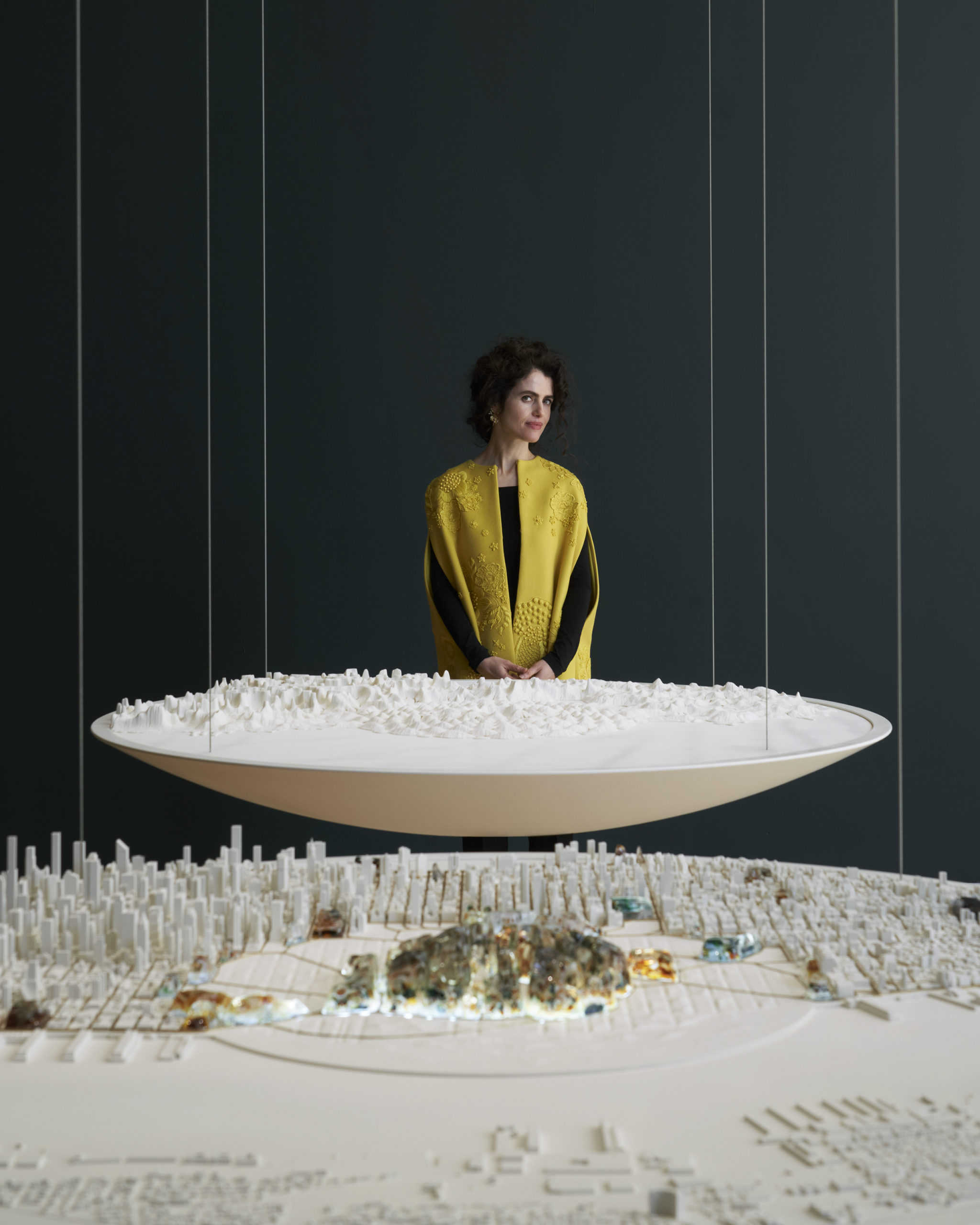
Oxman’s Man-Nahāta models are urban studies for Megalopolis, a forthcoming film by Francis Ford Coppola about an architect seeking to rebuild New York in the wake of disaster. To create them, the OXMAN team revisited the precolonial history of Manhattan, when it was known as Mannahatta, identifying and studying a period of rich biodiversity. The four site-specific models on view in the exhibition are suspended from the ceiling, and informed by climate projections and inspired by ancient circular habitats. All told they envision an ecological evolution in which Manhattan’s urban grid and Mannahatta’s biotic garden achieve symbiosis, offering a framework for architecture that grows, decays, and re-emerges, melding with nature across four centuries.
SFMOMA: This project looks back 400 years and forward 400 years. Architects often design with longevity in mind — hoping to stand the test of time in fabrication, aesthetics, and sustainability. How does the perspective of time in the proposed project Man–Nahāta expand on these ideas?
Neri Oxman: Four hundred years before Dutch settlers arrived, Manhattan was Mannahatta, the “land of many hills,” home to the Lenape people and over 55 ecological communities living in balance with Nature. Today, the island is a nucleus of human activity, but also faces a precarious future, subject to rising tides and heat hazards from climate change, further driving coastal flooding and storm surges at the island’s edges — once the most suitable terrain for human habitation.
Man–Nahāta proposes how the Manhattan grid and the Mannahatta hills can come together, literally and figuratively, re-envisioning a future for the city that reestablishes a healthy ecosystem and restores a balance between nature and humanity by embracing, rather than obstructing, our connection to the natural world. Instead of a linear timeline, we offer a circular one, where the relationship between different modes of time is a constant flow of restoration and renewal, mediating between the present and the past in hopes of reestablishing balance for future generations.
Time as a concept is wondrous and complex. It is incredibly humbling to accept wisdoms from cultures established thousands of years ago; to work with organisms that existed on this planet billions of years ago. Part of operating in the bio-digital age requires that we tune in and really listen to the living systems of the past so that we might begin to understand how to design for the future, all while maintaining connection with the present. Might we develop tools to work with ancient materials such as glass; design hybrid living wearables that support life in an unknown yet inevitable future; even invent machines to accelerate and share knowledge across space and time?
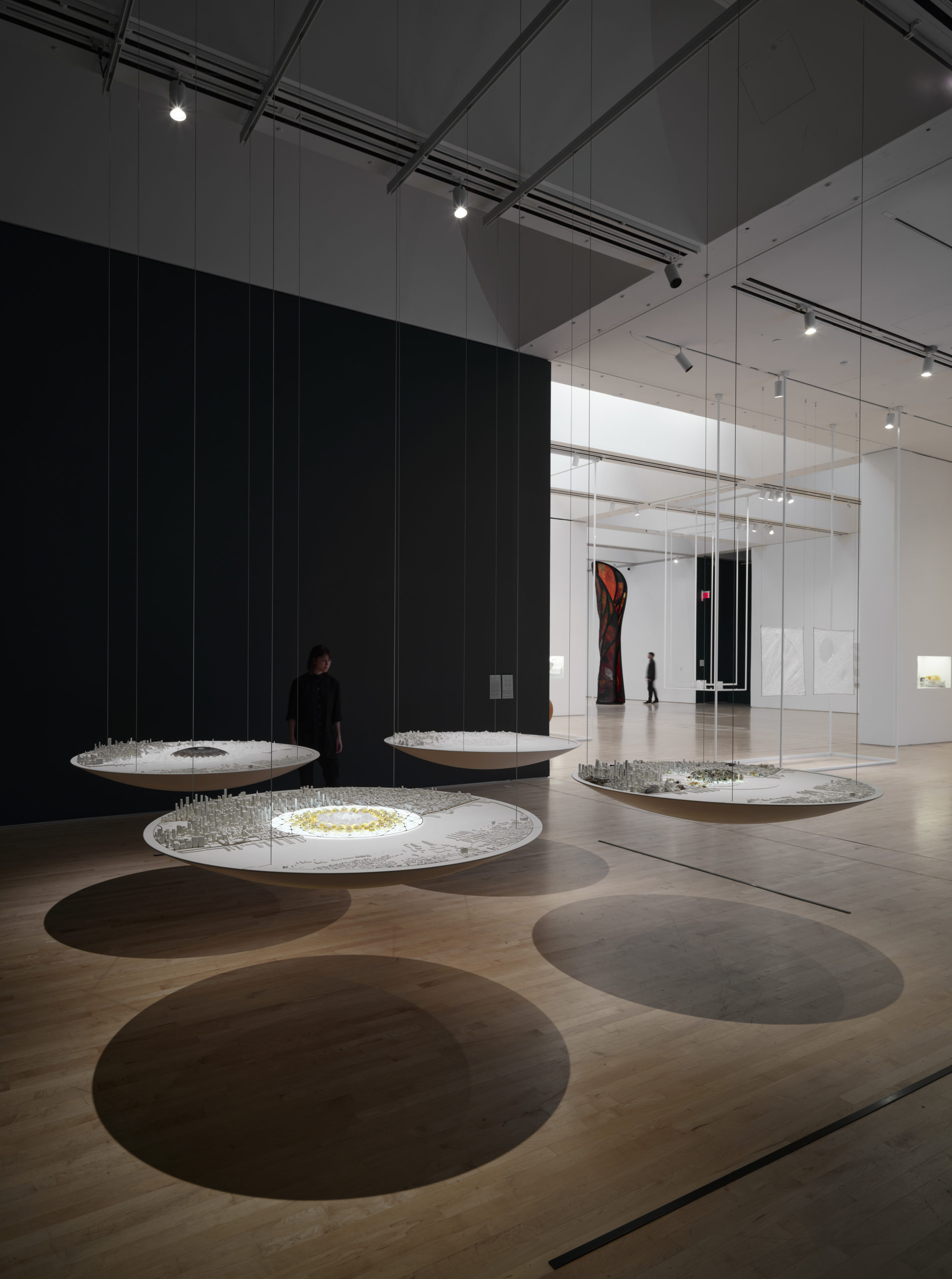
Aguahoja Pavilions: Printed by a Robot and Shaped by Water
“A tree becomes a building, a building becomes a tree.”
More than 300 million tons of plastic waste are produced globally each year, and less than ten percent is recycled; Much of what remains is dumped into landfills or rivers that carry into our world’s oceans—poisoning fish, animals, and our water supply in the thousands of years it can take to degrade. The United Nations estimates that there could be more plastic than fish in our oceans by 2050—a figure that becomes even more startling when considering mass production of plastics only began in the 1950s.
Responding to unsustainable construction practices that contribute to waste, Oxman and The Mediated Matter Group developed fabrication methods that are attuned to natural conditions and lifecycles. Almost sixteen feet tall, the Aguahoja pavilions are 3D printed structures that use 5,740 fallen leaves, 6,500 apple skins, and 3,135 shrimp shells as building materials that decay naturally, thereby enriching its environment rather than poisoning it. “The name Aguahoja emerges from the fusion of agua, meaning water, and hoja (pronounced o’-ha), meaning leaf, denoting at once the essence of its birth, life, and death,” Oxman explains.
There are three pavilions in the exhibition. One printed four years ago, from the museum’s collection, is located on the Floor 4 terrace. This older structure will decompose and nourish a flower bed during the course of the exhibition. Four weather gauges and a caloric clock installed indoors, just near the terrace, allow Oxman scientists to track the rate of decomposition.
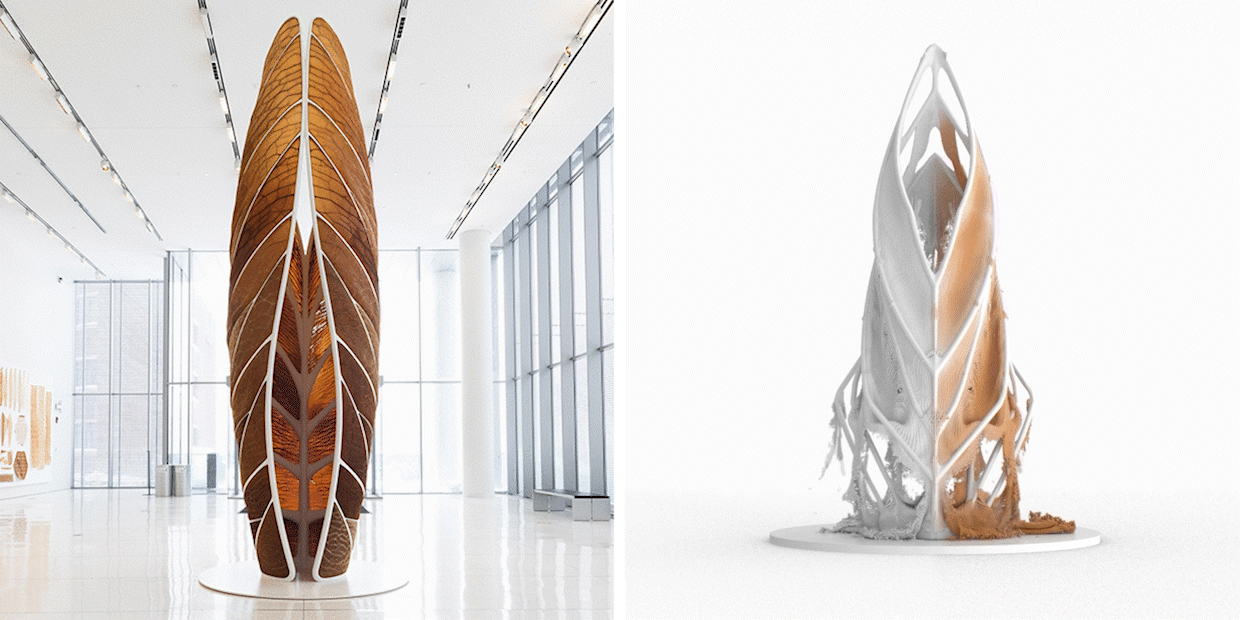
SFMOMA: What do you hope to learn from this experiment, and what do you hope visitors take away from witnessing the experiment in real time?
Neri Oxman: A suite of instruments measures the Aguahoja I pavilion’s rate of decay in context to its exposure to the elements on the Floor 4 terrace. The instruments capture environmental data (in addition to algorithmically synthesized information) through an on-site weather station, weather gauges, and a bespoke caloric clock. Four gauges located within the gallery, in close proximity to the installation, display real-time weather data such as wind, humidity, temperature, and precipitation. The compounded impact of the elements affects the decomposition and degradation of the pavilion, over space (i.e., shape deformation) and over time (i.e., rate of decay).
The caloric clock continuously updates a display of the total amount of calories remaining within Aguahoja I’s structure during its decay. The initial caloric footprint of the pavilion is estimated at 40,000 calories. The environmental impact factors tracked by the gauges are used in conjunction with the real-time weather data to subtract a daily caloric toll on the bio-composite pieces and to indicate how much energy has been transferred to the garden surrounding the pavilion.
The Aguahoja III “sister” pavilion is situated within the gallery. Exposed only to a pristine, weather-controlled environment, it serves as contrast and control for Aguahoja I in the outdoor setting.
Matter and stored energy embodied in the Aguahoja I pavilion will gradually give way to the natural process of decay and biodegradation, transforming into biomass anew, and fueling plant growth in the garden’s ecological niche.
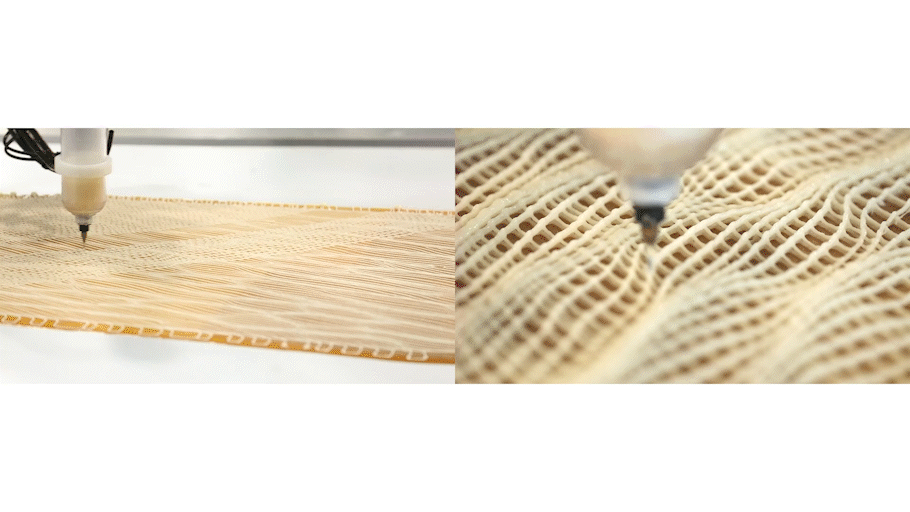
SFMOMA: What led you to conceive of shrimp shells as a fabrication material? What benefits could it offer as a building material?
Neri Oxman: My team and I wondered how we might augment digital design and robotic manufacturing with the most abundant biopolymers on our planet: cellulose, which is found in the cell walls of nearly all plants; chitosan, refined from chitin found in crustacean exoskeletons; and pectin, which is found in the skin of ripe fruits such as apples.
The diversity of forms and behaviors embodied in Aguahoja’s structure mirrors the manner in which, from a minimal palette of molecular components, nature constructs an extensive array of multifunctional materials with no synthetic parallels. A material such as chitosan manifests in the strong, hard exoskeletons of crustaceans such as shrimp and lobster, as well as in the extremely thin, transparent membranes of dragonfly wings and the soft tissue of fungi. In contrast to steel and concrete, the bio-composites formed by organic materials are in constant dialogue with their ecological niches, capable of dynamically adapting to changing environmental conditions.
Each unique material composition imparts specific properties such as stiffness, strength, and color. In contrast to most synthetic materials, the pieces that comprise Aguahoja will react to their environment over their lifespan, adapting their shape and color in response to natural fluctuations in heat, humidity, airflow, and sunlight. Upon exposure to rainwater, they degrade programmatically, restoring their constituents back to the environment. These material and environmental properties are simulated in advance of fabrication to directly inform design of material composition and structural form from the very beginning. Aguahoja thus embodies the Material Ecology design approach to material formation and decay by design.
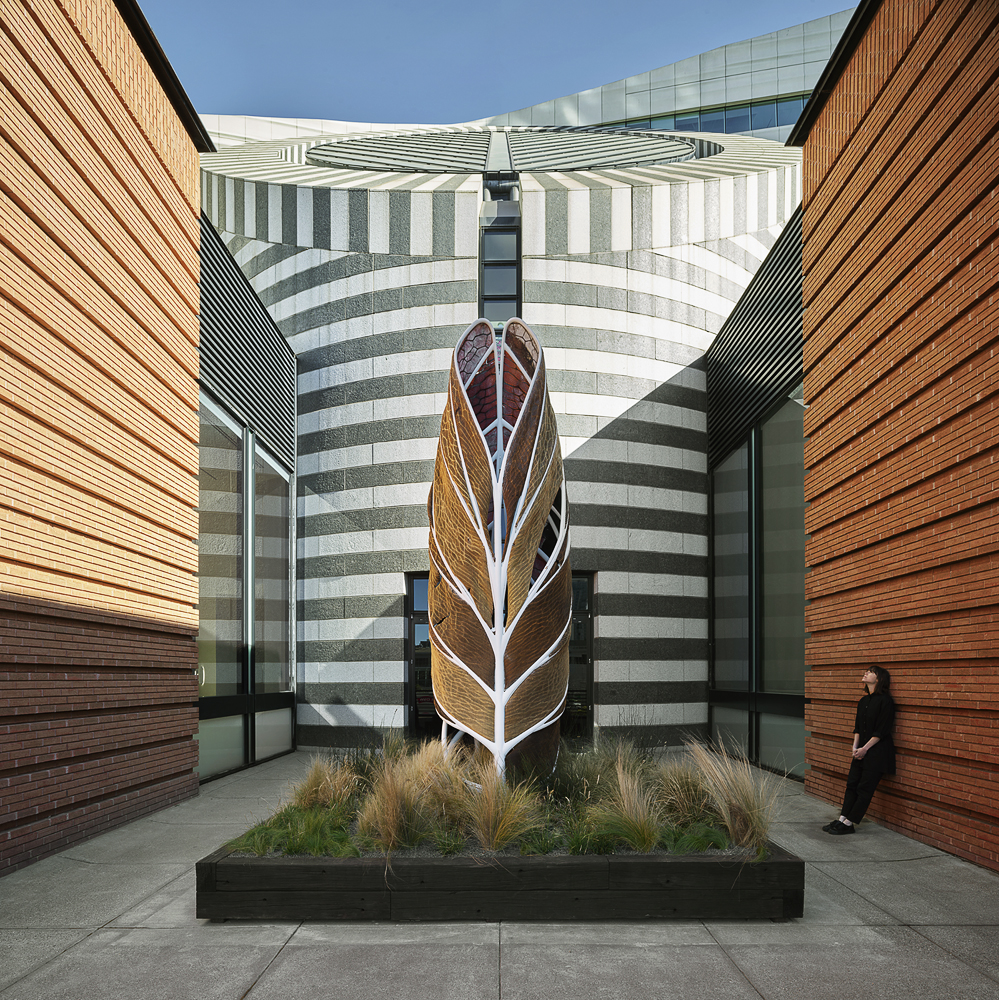
The “Pigment of Life” in Totems and Biodiversity Pavilion
“Melanin’s most striking feature lies in the duality of the biological and societal roles it has played throughout natural history.”
Oxman’s studio has been in search of materials and chemical substances that have weathered the perils of climate change and can sustain and enhance biodiversity across living systems. Melanin, the naturally occurring chemical chain giving all living things their pigmentation, is at least 307 million years old. It is one of the most resistant, heterogeneous, and widespread pigments found in all animal kingdoms. Researchers have been able to find its substance in fossils dating back to the Mesozoic Era, and today it can also be chemically synthesized in laboratories and with modern techniques. Two projects in the exhibition—Totems and Biodiversity Pavilion—speculate on how melanin could be synthesized for the betterment of biodiversity.
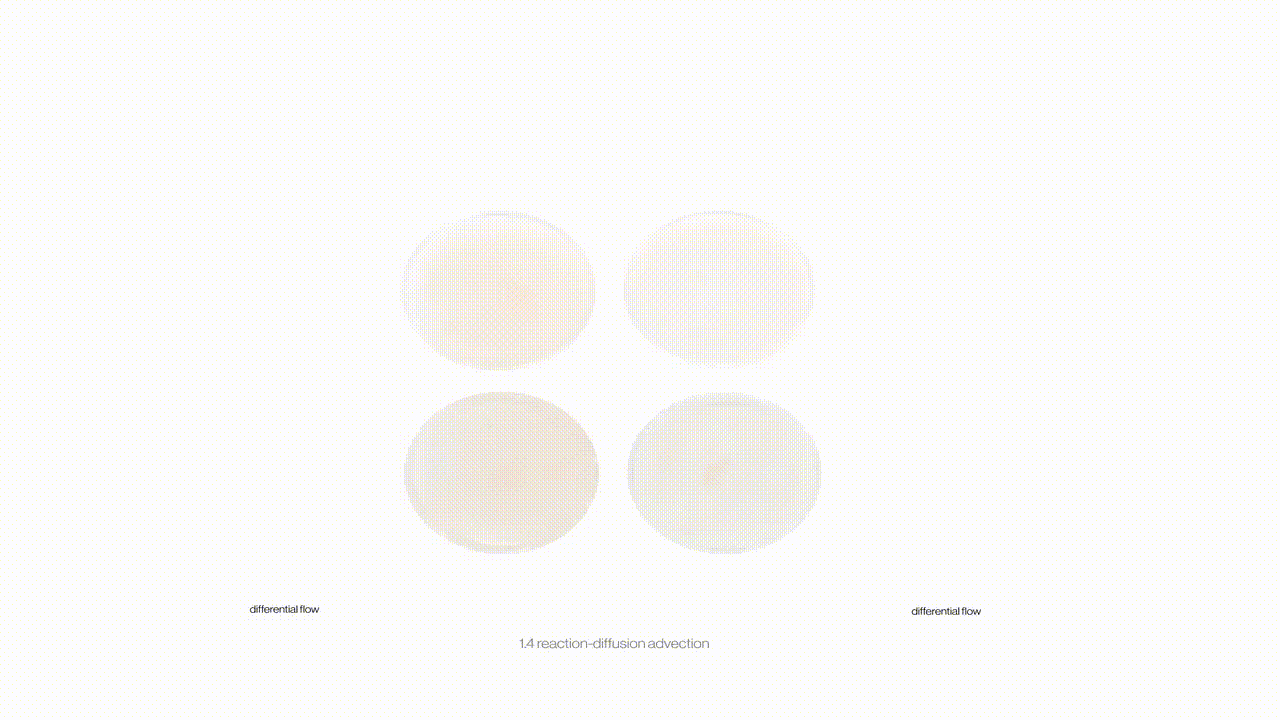
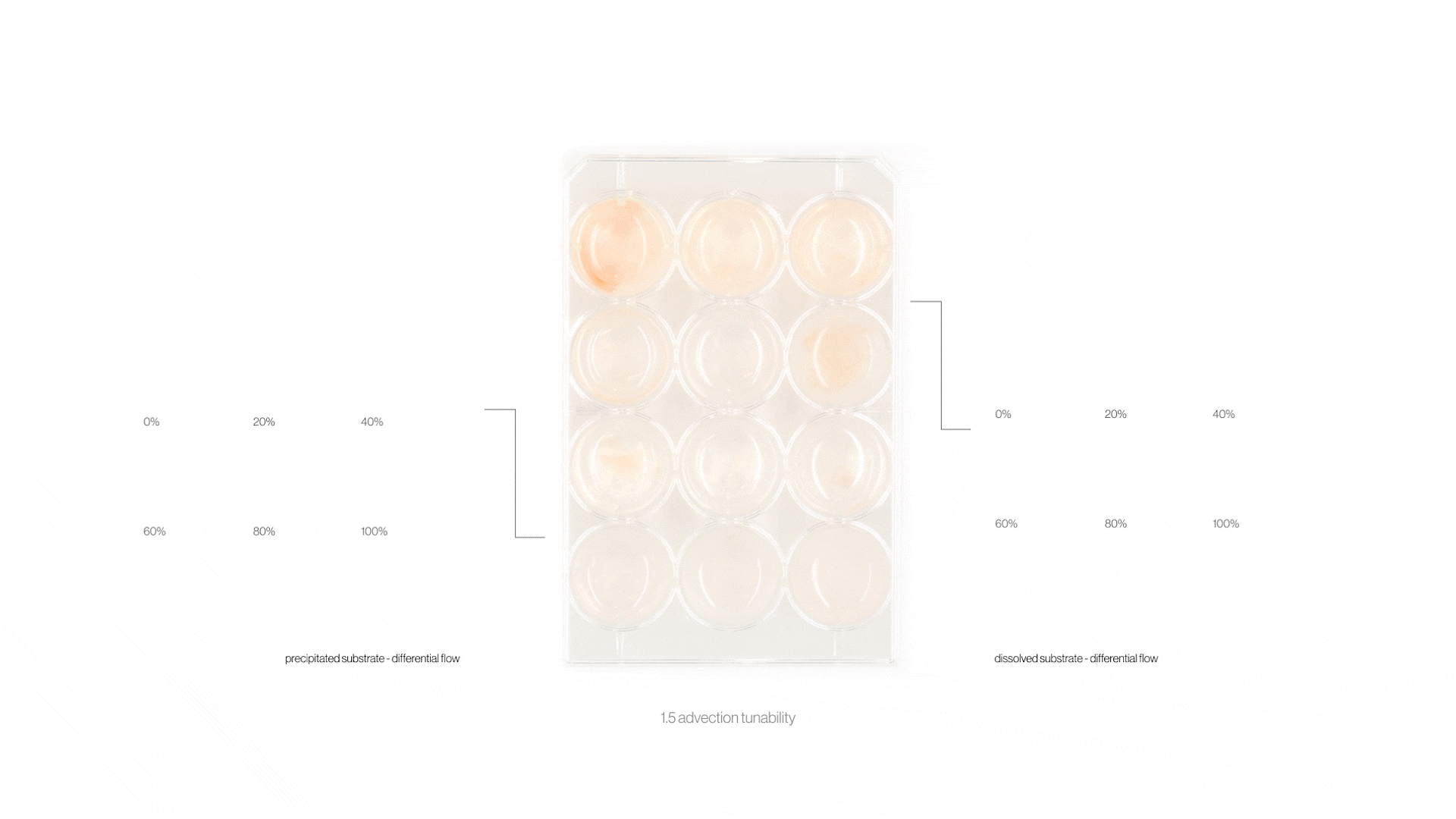
SFMOMA: Can you explain the ideas behind your melanin-based projects?
Neri Oxman: This series of projects explores how melanin, a natural protectant against ultraviolet radiation, might be extracted, channeled, or generated for use in building materials. Totems represents the first phase of our investigations of this substance.
As a part of these investigations, we developed methods to computationally “grow” complex 3D-printed channels and fill them with liquid melanin produced on demand, important steps in harnessing its use. We apply these concepts on an architectural scale in the Biodiversity Pavilion, a design for an environmentally responsive melanin-infused structure that could provide protection against ultraviolet rays by becoming opaque to create shade at peak sun and fading to transparent as the sun sets.

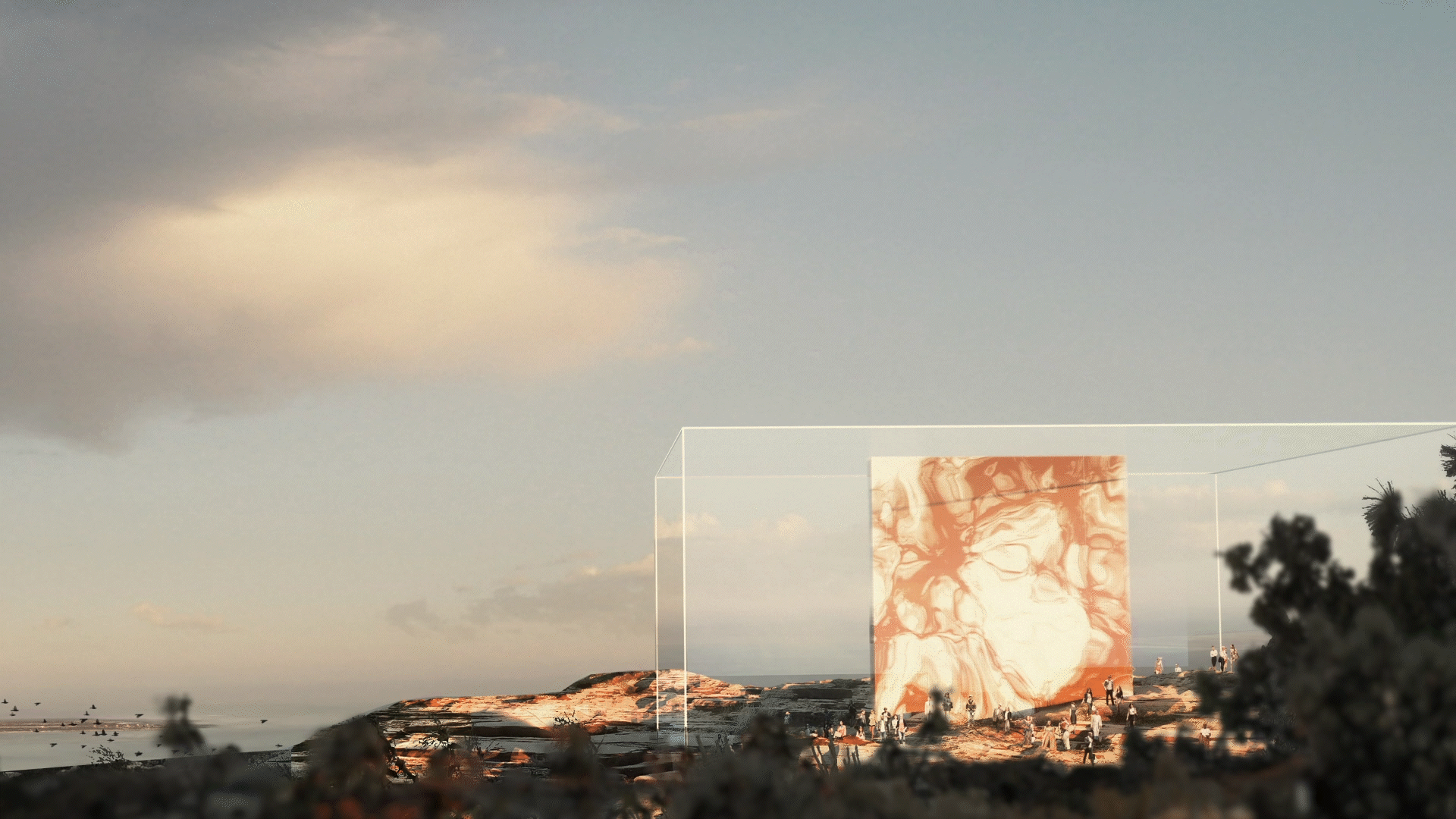
SFMOMA: Skin color has long been used to divide and separate people. Is there a larger statement your melanin-based projects are making by using this often-politicized biological substance as a potential way to address environmental and sustainability concerns we now face?
Neri Oxman: When dealing with materials that carry such deep meaning, it becomes challenging to separate between biology and technology, or between Nature and culture. They become intertwined. So far, our work has been environmentally informed but, in general, culturally agnostic. Totems and the Biodiversity Pavilion have taken us further into design territories that are culturally charged. Indeed, melanin’s most striking feature lies in the duality of the biological and societal roles it has played throughout natural history. While it has been biologically protective across all kingdoms of life, melanin has also had a societally harmful effect.
This duality in melanin’s biological and societal roles offers a critical lens for design and designers who are engineering living systems with profound implications — both technological and cultural. We are honored to have received a commission through Design Indaba for our work on Biodiversity Pavilion, designed for a site at Table Mountain National Park in Cape Town, South Africa that Ravi Naidoo, founder of Interactive Africa and Design Indaba, describes as “where man first stood straight and walked north.” We look forward to seeing this work into its architectural embodiment.
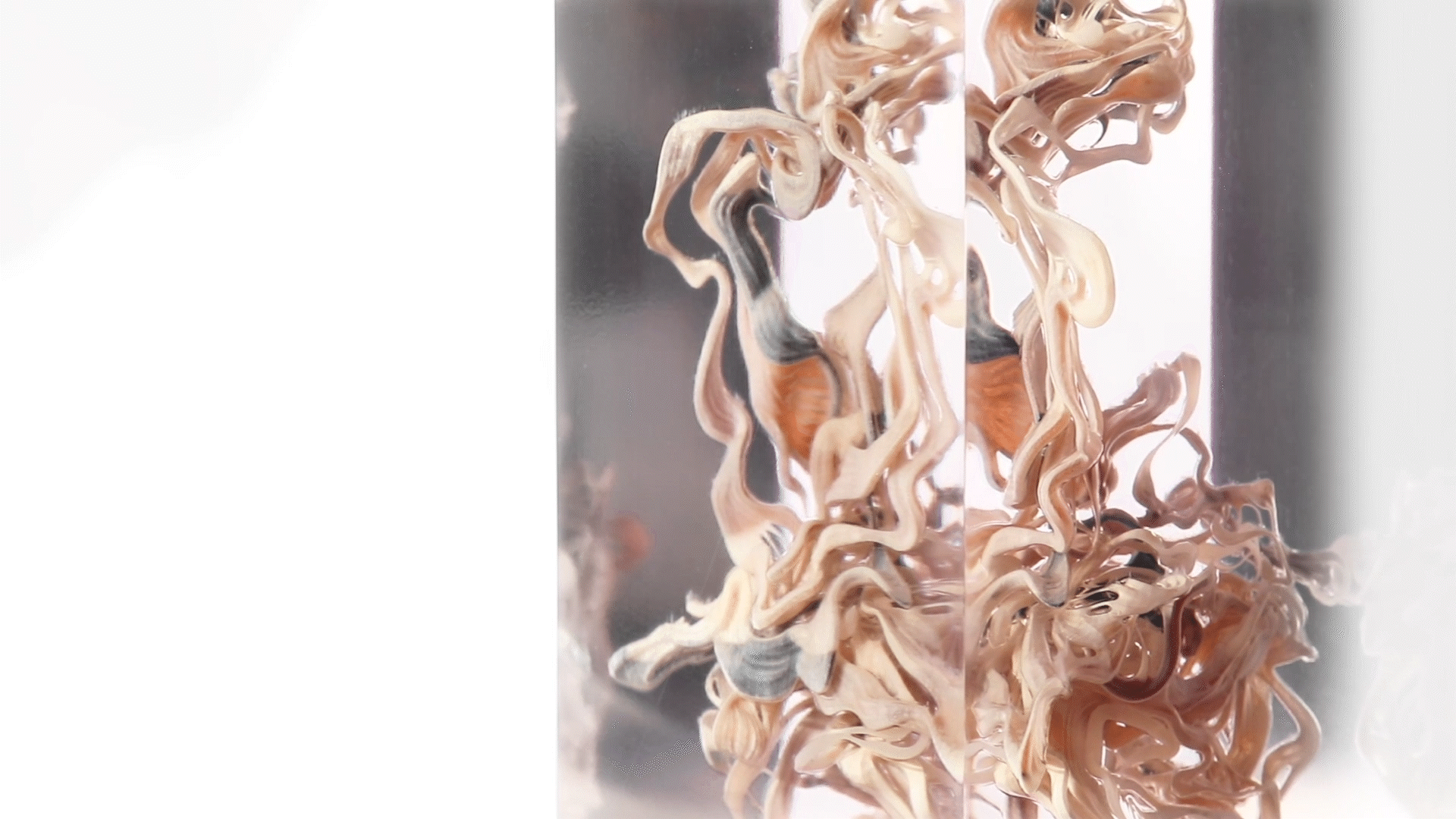
SFMOMA: What is the significance of the title “Totems”?
Neri Oxman: While most design practices are shaped around the needs and desires of the human species, this project suggests that we consider all living creatures as equals, across kingdoms, phylum, orders and species.
The project was inspired by the totem poles of the Pacific Northwestern Indigenous peoples of North America. These vertical poles often feature different designs denoting faunae (and flora) including bears, birds, frogs, people, as well as various supernatural beings and aquatic creatures believed to embody spiritual significance, depicted as three-dimensional statuaries located one on top of the other. Such spirit beings are usually classified by kingdoms and include plants, animals (including humans), protists, fungi, archaebacteria, and eubacteria. When we realized that melanin — the pigment of life — is found across all kingdoms of life and that it is considered a biomarker of evolution, we were drawn to reinterpret the tree of life not as a hierarchy of discreet organizational elements (e.g., domain, kingdom, phylum, class, order, family, genus, species), but rather as a continuum accounting for features and their expressions beyond how an organism is identified.
The columns exhibited in this series contain pigments extracted from six different species of organisms from the air and from the sea, and they are all entangled: a primordial soup. Artifacts such as feathers and ink are broken down, filtered, and processed through a chemical design protocol to yield strong and unique pigments true to their host organisms. Each column therefore functions as a biological totem—and is initiated with the introduction of tyrosinase, an enzyme that leads to color formation that continues over the span of a day, deepening as the sun reaches its zenith. In this way, the demonstration is a “window” into the pigment that provides protection from, connection to, and transformation of sunlight, and is integrated into the biology of so many forms of life on Earth.
Check out Neri’s exhibition in SF Moma until May 15th.
